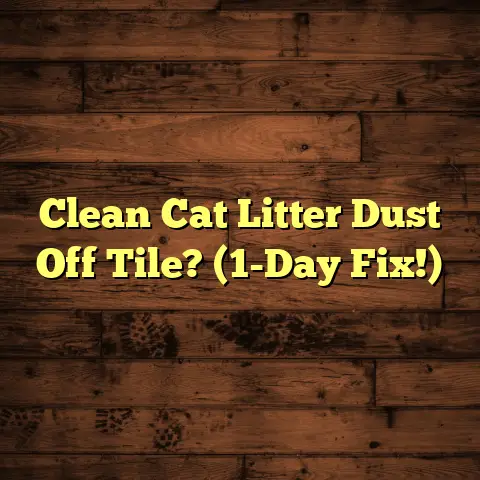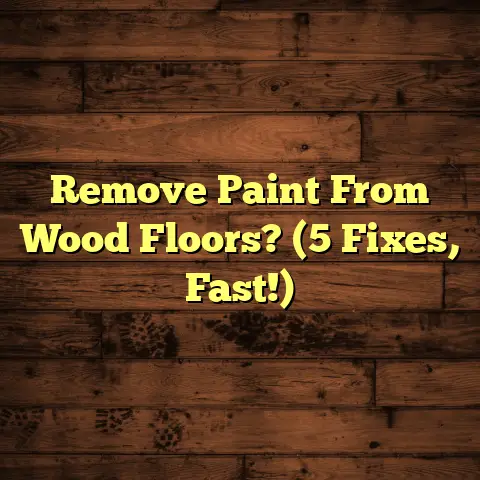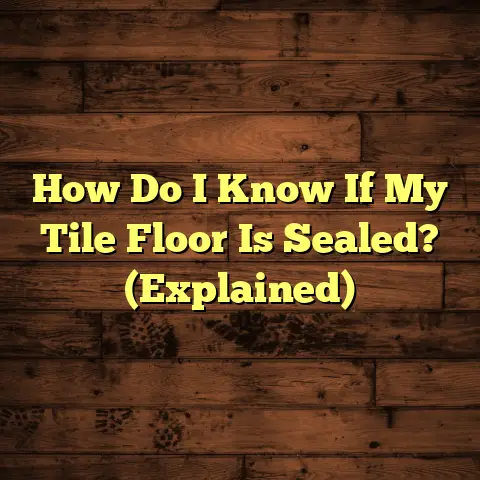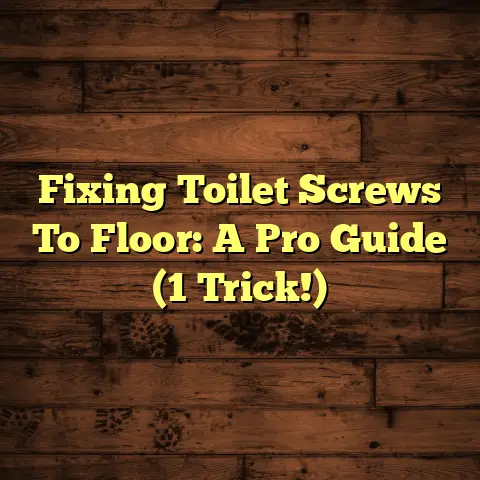Steam Clean Vinyl Tiles? (3 Risks Exposed!)
I’m Mike, a flooring contractor with over 15 years of experience. I’ve seen it all when it comes to flooring – the good, the bad, and the downright ugly.
And today, I want to chat about something that’s been popping up more and more: steam cleaning vinyl tiles.
We all want a clean and healthy home, right? Especially in those high-traffic areas like kitchens and bathrooms. Vinyl tiles, with their resilience and affordability, have become a super popular choice.
But, here’s the thing: steam cleaning, while often touted as a miracle solution for killing germs and banishing tough stains, isn’t always the best option for everything.
In fact, when it comes to vinyl tiles, there are some serious risks you need to be aware of. I’m talking about potential damage, moisture problems, and even voiding your warranty!
So, grab a coffee, settle in, and let’s dive into the 3 major risks of steam cleaning vinyl tiles. Trust me, knowing this could save you a lot of headaches (and money!) down the road.
Understanding Vinyl Tiles
Okay, let’s start with the basics: what exactly are vinyl tiles?
Well, they’re essentially a type of resilient flooring made from synthetic materials, primarily PVC (polyvinyl chloride). Think of it as a durable, water-resistant alternative to natural materials like wood or stone.
There are a few different types you’ll typically see:
-
Sheet Vinyl: This comes in large rolls and is installed as a single, seamless sheet. It’s great for areas prone to moisture, like bathrooms, because there are fewer seams for water to seep through.
-
Vinyl Tiles: These are individual squares or rectangles that are installed piece by piece. They offer more design flexibility than sheet vinyl and are easier to replace if one gets damaged.
-
Luxury Vinyl Tile (LVT): This is the premium option, often designed to mimic the look of wood or stone. It’s thicker and more durable than standard vinyl tiles and offers a more realistic appearance.
Now, why are vinyl tiles so popular? Well, there are a few key reasons:
-
Durability: Vinyl is tough stuff. It can withstand a lot of foot traffic and resist scratches and dents.
-
Water Resistance: This is a big one! Vinyl doesn’t absorb water, making it ideal for kitchens, bathrooms, and laundry rooms.
-
Aesthetic Appeal: Vinyl comes in a huge range of colors, patterns, and styles. You can find something to match just about any décor.
-
Affordability: Compared to materials like hardwood or ceramic tile, vinyl is relatively inexpensive.
-
Easy Maintenance: Generally, vinyl is easy to clean. Regular sweeping and mopping usually do the trick.
Because of these advantages, vinyl tiles are used everywhere. From residential kitchens and bathrooms to commercial spaces like offices, hospitals, and retail stores.
Now, when it comes to cleaning, most people stick to traditional methods like sweeping, vacuuming, and mopping with a mild detergent. But, with the rise of steam cleaners, many homeowners are wondering if they can use this method to get their vinyl floors extra clean.
And that’s where things get tricky.
The Steam Cleaning Process
So, what exactly is steam cleaning, and why is it becoming so popular?
Well, in a nutshell, steam cleaning uses hot steam to clean and sanitize surfaces. The equipment itself, a steam cleaner, typically consists of a water tank, a heating element, and a nozzle or attachment to direct the steam.
Here’s how it works:
- The water tank is filled with water.
- The heating element heats the water to a high temperature, creating steam.
- The steam is then forced through the nozzle or attachment, blasting the surface with hot, pressurized moisture.
The combination of high temperature and pressure is what makes steam cleaning so effective. The heat helps to loosen dirt, grime, and stains, while the pressure helps to blast them away. Plus, the high temperature can kill bacteria, viruses, and other germs, making it a great way to sanitize surfaces without using harsh chemicals.
This is why steam cleaning has become so popular for a variety of surfaces, including:
-
Hardwood Floors: Though even with hardwood, you need to be careful.
-
Tile and Grout: Steam can penetrate deep into the grout lines to remove stubborn dirt and mildew.
-
Upholstery: Steam can freshen up fabrics and kill dust mites.
-
Bathrooms and Kitchens: Steam can sanitize surfaces and remove tough stains.
The perceived benefits of steam cleaning vinyl tiles are pretty clear: convenience and effectiveness. It’s a quick and easy way to clean large areas, and it promises to kill germs and remove stubborn stains without the need for harsh chemicals.
But, as I mentioned earlier, there are some hidden risks when it comes to using steam cleaners on vinyl tiles. Let’s get into the first one.
Risk 1 – Damage to Vinyl Tiles
This is the big one, folks. The most significant risk of steam cleaning vinyl tiles is the potential for damage.
You see, vinyl is a synthetic material, and while it’s durable, it’s also sensitive to extreme heat. The high temperatures produced by steam cleaners can actually warp, melt, or otherwise damage the surface of your vinyl tiles.
Think about it: steam cleaners typically generate steam at temperatures of 200°F (93°C) or higher. While this might be fine for some surfaces, it’s simply too hot for vinyl.
Here’s what can happen:
-
Warping: The heat can cause the vinyl to soften and lose its shape, leading to warping or buckling.
-
Melting: In extreme cases, the heat can actually melt the surface of the vinyl, leaving behind a sticky or disfigured mess.
-
Peeling: The heat can weaken the adhesive that bonds the vinyl to the subfloor, causing the tiles to peel up at the edges or corners.
-
Discoloration: The heat can also cause the vinyl to fade or discolor, especially if it’s exposed to direct sunlight.
-
Texture Changes: Steam cleaning can alter the texture of the vinyl, making it feel rough or uneven.
I’ve seen this happen firsthand on numerous occasions. I remember one client who steam cleaned their luxury vinyl plank flooring, thinking it would be a quick and easy way to get it sparkling clean. Instead, they ended up with warped and discolored planks that had to be replaced. The cost of replacement was around $3,000, a hefty price to pay for a cleaning shortcut!
The key here is temperature regulation. Not all steam cleaners are created equal. Some have adjustable temperature settings, while others operate at a fixed temperature. If you’re going to use a steam cleaner on vinyl, it’s crucial to choose one with adjustable temperature settings and to use the lowest possible setting.
However, even with temperature regulation, there’s still a risk of damage. It’s simply not worth the risk, in my opinion.
Risk 2 – Moisture Issues
Okay, let’s talk about another major risk associated with steam cleaning vinyl tiles: moisture issues.
Even though vinyl is water-resistant, it’s not completely waterproof. Water can still seep into the seams and edges of the tiles, especially if there are any gaps or cracks.
And when you’re steam cleaning, you’re essentially blasting your floor with hot, moist air. This can force moisture into those seams and edges, creating a breeding ground for mold and mildew.
Here’s the problem:
-
Mold and Mildew Growth: Mold and mildew thrive in damp, dark environments. The moisture that gets trapped beneath the vinyl tiles provides the perfect conditions for them to grow.
-
Structural Damage: Over time, mold and mildew can damage the subfloor beneath the vinyl, leading to structural problems.
-
Health Risks: Mold and mildew can also pose serious health risks, especially for people with allergies or asthma.
I’ve seen cases where homeowners have steam cleaned their vinyl floors for years without any apparent problems. But then, one day, they start to notice a musty smell or see signs of mold growth around the edges of the tiles. By that point, the damage is often extensive and requires professional remediation.
One of the biggest issues is that moisture can get trapped underneath the vinyl flooring. This is especially true for sheet vinyl, where the seams are sealed, but moisture can still seep in around the edges of the room. Once moisture is trapped underneath, it can be very difficult to remove.
Proper drying techniques are crucial to mitigate moisture-related issues. After steam cleaning, you need to make sure that the floor is completely dry. This means wiping up any excess moisture with a clean, dry cloth and using fans to circulate air in the room.
However, even with the best drying techniques, there’s still a risk of moisture getting trapped beneath the vinyl. And once that happens, it’s only a matter of time before mold and mildew start to grow.
Risk 3 – Warranty and Manufacturer Guidelines
Alright, let’s talk about something that often gets overlooked: warranty and manufacturer guidelines.
Most vinyl flooring manufacturers have specific recommendations for cleaning and maintaining their products. And guess what? Many of them explicitly warn against using steam cleaners.
Here’s why this is important:
-
Voiding the Warranty: If you use a steam cleaner on your vinyl floor against the manufacturer’s recommendations, you could void your warranty. This means that if something goes wrong with your floor, the manufacturer won’t cover the cost of repairs or replacement.
-
Ensuring Longevity: Following the manufacturer’s guidelines is the best way to ensure the longevity of your flooring. They know their products best and have tested different cleaning methods to determine what works and what doesn’t.
I’ve seen homeowners who have had their warranties voided because they used steam cleaners on their vinyl floors. They thought they were doing the right thing by keeping their floors clean, but they ended up paying the price in the long run.
For example, Shaw Floors, one of the largest flooring manufacturers in the world, explicitly states that steam cleaning is not recommended for their vinyl flooring products. They recommend using a pH-neutral cleaner and a damp mop instead.
Similarly, Armstrong Flooring, another leading manufacturer, advises against using steam cleaners, as they can damage the surface of the vinyl and void the warranty.
The financial implications of voiding your warranty can be significant. Replacing a vinyl floor can cost thousands of dollars, depending on the size of the area and the type of vinyl you choose. And if you’ve voided your warranty, you’ll be on the hook for the entire cost.
So, before you even think about using a steam cleaner on your vinyl floor, take a look at the manufacturer’s recommendations. You can usually find this information on their website or in the product documentation.
Trust me, it’s worth taking a few minutes to read the fine print. It could save you a lot of money and headaches down the road.
Conclusion
Okay, let’s wrap things up.
We’ve covered a lot of ground in this article, and I hope you now have a better understanding of the risks associated with steam cleaning vinyl tiles.
To recap, the three main risks are:
-
Damage to Vinyl Tiles: The high temperatures produced by steam cleaners can warp, melt, or discolor your vinyl flooring.
-
Moisture Issues: Excessive moisture from steam cleaning can seep into seams and edges, leading to mold and mildew growth.
-
Warranty and Manufacturer Guidelines: Using steam cleaners can void your warranty and go against the manufacturer’s recommendations.
I want to emphasize that I’m not saying that steam cleaning is always a bad idea. For some surfaces, it can be a very effective cleaning method. But when it comes to vinyl tiles, the risks simply outweigh the benefits.
It’s always best to err on the side of caution and stick to the manufacturer’s recommended cleaning methods. Usually, a pH-neutral cleaner and a damp mop will do the trick.
Remember, your vinyl floor is an investment. By taking care of it properly, you can ensure that it lasts for many years to come.
So, the next time you’re tempted to reach for the steam cleaner, take a moment to consider the risks. Your vinyl floor will thank you for it!





